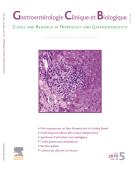Is physical activity possible and beneficial for patients with hepatitis C receiving pegylated interferon and ribavarin therapy? - 22/01/09
 , F. Pillard b, V. Mascarell a, D. Rivière b, P. Couzigou c, N. Kharlov d
, F. Pillard b, V. Mascarell a, D. Rivière b, P. Couzigou c, N. Kharlov dSummary |
The great majority of patients with chronic viral hepatitis C are treated with pegylated interferon-ribavirin therapy. The aim of this study was to demonstrate that these patients were able to have some form of physical exercise, and that this activity can lead to an improvement in their quality-of-life. Twelve volunteer patients with hepatitis C, who were either sedentary or had become sedentary and who had been treated by combination therapy for the past few weeks, were recruited at hepatology clinics in the Midi-Pyrénées region of France early in 2006. All patients attended a sports medicine consultation for an initial evaluation: maximal aerobic power and maximal oxygen consumption tests, maximum heart rate (MHR), search for contraindications for participation in the proposed program of physical exercise. The patients were given a heart rate monitor so they could measure their heart rate during physical exercise and check that they exercised under safe conditions and remained within the so-called “endurance” zone. The patients came to a sports facility daily for 5 days for the exercise program. The activities were divided into four sessions each day: an individual physical exercise selected by the patient, team physical exercise, recreational physical exercise, lectures on the different types of hepatitis and their treatment, on nutrition and on sports medicine assessments. Data on hepatitis, results of the cardiorespiratory examination and personal history and record of past physical activity were collected for each patient. Quality-of-life (SF36) was assessed at enrolment in the study and one month after the training sessions. At the initial sports medicine consultation, all patients reached their MHR and were found capable of participating in the proposed physical exercise program. One enrolled patient was excluded from the analysis because of the presence of sinusitis on arrival. Seven men and four women, mean age of 46 years completed the full course of the study protocol. All participated in the three types of proposed physical activity with no problem. The score of the general perception item of the SF36 questionnaire increased from 63 on day 0 to 71 at one month (p=0.07). In conclusion, patients with hepatitis C receiving pegylated interferon plus ribavirin may safely participate in a program of suitably supervised physical exercise. Taking part in physical exercise leads to clear changes in the way patients perceive their bodies and its capacities. Participating in sports activities could improve self-confidence and lead to far-reaching changes in the way patients perceive their disease and the constraints of treatment.
Il testo completo di questo articolo è disponibile in PDF.Résumé |
La très grande majorité des malades atteints d’hépatite chronique C traités par bithérapie interféron pégylé et ribavirine devient totalement sédentaire. Le but de cette étude était de montrer qu’une reprise de l’activité physique était possible chez ces malades et qu’elle améliorait la qualité de vie. Début 2006, 12malades sédentaires ou devenus sédentaires, ayant une hépatite C et recevant une bithérapie pégylée depuis quelques semaines ont été recrutés à partir des consultations d’hépatologie de la région Midi-Pyrénées. Pour chaque malade, une consultation dans un service de médecine du sport a permis : de mesurer la puissance maximale aérobie et la consommation maximale d’oxygène, de calculer leur fréquence cardiaque maximum (FCM) ; de délivrer un certificat de non contre indication à la pratique d’une activité physique et de régler individuellement un cardiofréquence mètre fourni pour l’activité physique. Ainsi, cette pratique était sans danger et réalisée dans la zone dite « d’endurance ». Les malades étaient accueillis cinq jours dans un lieu adapté à la pratique de l’activité physique. L’activité quotidienne était répartie en quatre temps dans la journée : activité physique individuelle choisie par le malade, activité physique collective, activité physique ludique et conférences sur les thèmes des hépatites virales et de leurs traitements, diététique, évaluation en médecine du sport. Les données pour chaque malade concernant sa maladie hépatique, ses antécédents personnels et sportifs, son examen cardiorespiratoire étaient colligées ainsi qu’une évaluation de la qualité de vie (SF36) prévue à l’entrée dans l’étude et à un mois après le stage. Au cours de la consultation de médecine du sport, les 12malades étaient aptes à la pratique d’une activité physique et ont atteint la FCM. Un malade a été exclu car il avait une sinusite purulente à l’arrivée dans le stage. Sept hommes et quatre femmes, d’âge moyen 46ans ont effectué le stage complet. Ils ont réalisé les trois types d’activité sans problème. Le paramètre perception générale du questionnaire SF36 est passé de 63 au jour zéro à 71 au mois 1 (p=0,07). En conclusion, cette étude montre que la pratique d’une activité physique chez des malades atteints d’hépatite C traités par interféron pégylé et ribavirine est possible et sûre si elle est encadrée. Cette pratique entraîne un changement sensible pour les malades de leur perception de leur corps et de ses capacités. Elle pourrait améliorer la confiance en soi et transformer profondément le regard que les malades portent sur leur maladie et les contraintes du traitement.
Il testo completo di questo articolo è disponibile in PDF.Mappa
Vol 33 - N° 1P1
P. 8-14 - Gennaio 2009 Ritorno al numeroBenvenuto su EM|consulte, il riferimento dei professionisti della salute.

